AUCTORES
Globalize your Research
Research Article | DOI: https://doi.org/10.31579/2637-8914/089
1 Director of Irrigation and Draining Research, Sugarcane Research and Training Institute, Iran.
2 Professor Department of Irrigation and Drainage, Shahid Chamran University of Ahvaz, Iran.
*Corresponding Author: A. Sheini-Dashtghol, Director of Irrigation and Drainaing Research, Sugarcane Research and Training Institute, Iran.
Citation: A. Sheini-Dashtghol. (2022). Evaluating the Hydraulic Performance of Emitters of Subsurface Drip Irrigation Systems in Sugarcane Cultivation in Iran. J. Nutrition and Food Processing. 5(2); DOI: 10.31579/2637-8914/089
Copyright: © 2022 A. Sheini-Dashtghol. This is an open access article distributed under the Creative Commons Attribution License, which permits unrestricted use, distribution, and reproduction in any medium, provided the original work is properly cited.
Received: 10 March 2022 | Accepted: 28 March 2022 | Published: 26 April 2022
Keywords: SDI; hydraulic evaluation; emission uniformity; coefficient of variation
To ensure optimal operation of the drip irrigation systems, should be evaluated periodically. This research was designed to evaluate the technical and hydraulic evaluation of subsurface drip irrigation system in sugarcane plant in research station sugarcane research and training institute of Khuzestan during 2016-2017 and 2017-2018 growing season. For this study, four laterals were selected in experimental field (primary, one third and the last lateral) and four sections were determined on each laterals of the first, one third, two thirds and the last section. Then the volume of effluent water was measured for three minatory at any point measurement and evaluation system parameters were calculated. Results of the evaluation of the droplets in the laboratory showed that the Cv, Cu and Eu coefficient were 15, 90 and 84 percent and the values of the power x and the k coefficient in the discharge-pressure equation were, respectively, -0.043 and 2.41, respectively. Mean Cu, Eu, Vqs and Uqs during two growing seasons average, respectively 89.2, 87.8, 10.3 and 89.7 percent, that based on these results, system performance is generally in the range of well-placed Also, by measuring pressure at different points of the system in the middle of the second crop season, the ASAE assessment indicators Containing: Vqs, Uqs,Vhs and Vpf were respectively, 9, 91, 25 and 13 percent. System is considered to be relatively good and good in terms of the overall performance of the droplet and uniformity of distribution.
It is considered that most of Iran's water resources are consumed in agriculture and water use efficiency is less than 44% (Abbasi et al. 2017). The optimal use of water resources should be as the main option of agricultural development which needs to be considered (Uniformity of distribution is the main criterion which is considered in designing of an efficient drip irrigation system). Many factors, such as emitter clogging, water temperature change, pressure and the coefficient of variation (CV), affect the uniformity of water distribution. Changing each factor, will reduce the performance of the drip irrigation system (Valipour, 2012, Mohammed Elamin, 2017). Also, the type of emitter and the coefficient of variation (CV), play an important role in the hydraulic performance of a system (Valipour, 2012, Bush et al 2016, Mohammed Elamin, 2017).
Considering the importance of this issue, extensive research has been carried out on the evaluation of drip irrigation systems in the world. Here are some small examples of these studies. Puig-Bargues et al. (2010), studied two types of self- controlled pressure emitter in subsurface and surface systems, found that emitters clogging in the subsurface system is three percent higher than the surface system. Zamaniyan et al. (2014), studyied 10 fields in different parts of Iran, and measured different parameters of water quality and emitters clogging, evaluated different indexes of irrigation systems, they including Us, Eu and Vpf, by average of 52.8, 61 and 38.2% respectively. Bush et al. (2016), measured the values of (Du, Cu and CV), with comparison of two types of pressure regulating and non- regulating emitters at three levels of pressure 1, 1.5 and 1.75 bar. Their results showed that the pressure regulating emitters (Du, Cu and CV), values were 87%, 91%, and 3%, respectively, with the best hydraulic performance.
Ranjan et al. (2018) investigated the performance of a SD system at pressures of 0.6, 0.8, 1 and 1.2 bar. The flow constant (k) and flow exponent (x) were 1.284 and 0.573 respectively. Saxena et al. (2019), studied the hydraulic performance of a subsurface diameter system with two depths of 15 and 20 centimeters. Eu and Cu values for the depth of 15 cm were 93 and 95%, respectively and the performance of the system is in excellent class. For the importance of evaluation, and the fact that only subsurface drip irrigation systems used in sugarcane cultivation of Iran were limited to two systems in the southern of the country. Evaluation of the performance of these systems can lead to future designment for drip irrigation of sugarcane cultivation in this area. Therefore, evaluation of the performance of these systems was studied during two years (agronomical season) of 2016-2018.
This studied were carried out in field with area 1.2-ha that be under cultivation sugarcane (Cultivar CP69-1062), and in two years, the plant and first ratoon sugarcane are studied respectively. The research was located in research station of Khuzestan sugarcane research and training institute, situated at 30 km of Ahvaz-Abadan Road, with 33°, 48 ' eastern longitude, 59°, 30' north latitude and the level from sea was 7.6 m. Based on the division of De-martonne, the region's climate is warm and dry. The specifications of these irrigation systems are listed in TABLe (1).

Soil texture was determined by hydrometer method (Boayoacos, 1962), is reported in group of silty clay loam. Using a pressure plate, the mean values of field capacity and permanent wilting point were 0.37 and 0.19 cm3/cm3, respectively. The source of irrigation water was from Karoon River in Khuzestan province, Iran. The pumping and filtration station included hydrocyclone, sand and disc filters. Physical and chemical characteristics of soil and irrigation water are presented in Tables 2 and 3.


Table 2 shows that due to the constant texture and physical properties of the soil in different depths, the soil had no effect on the uniformity of emitter distribution. Emitters are a type of pressure controlled and anti-siphon. According to the information of catalog, these emitters were made according to IS 13488: 2008 and ISO 9261: 2004 standards and made from ESCR. The emitters discharge is 1.2 and 2.2 (l/h), with a nominal diameter of 16, inside diameter of 14.2 mm and minimum wall thickness of 0.7 mm that it is in the class 2 of emitting pipe. In figure 1. Catalog images included an emitting pipe, filter and outlet and in table 4, the basic information of it's in the catalog is shown.


In Figures 2 and 3, the relationship between the flow rate discharge variations and the pressure variations and the ratio of the emitter space to the maximum lateral length for 1 and 2 (l/h) are shown.
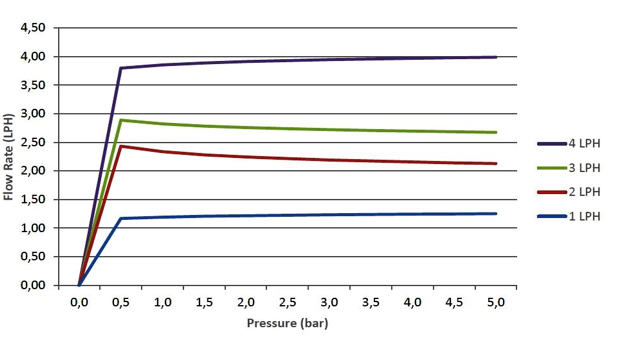

According to the diagrams of the catalog, the variation of the discharge is equal to 0.05 to 0.5 MPa pressure ranges. The information of the catalog was used to determine the maximum lateral length, flow rate distance of the emitters and the pressure required for the pumping station in the initial design. The discharge of the emitters in the laboratory were measured at various pressures of 0.22, 0.25, 0.27, 0.31 and 0.32 MPa. These pressures are common pressures which are used in the fields. To do these experiments, 50 meters from each emitting pipes were moved to the lab. The pipes were cut in equal parts of one meter and the pieces were connected to the branches of a main pipe. The end of event piece was blocked and the discharge rate of each piece was measured with a calibrated container over three minutes. The pressure of the water at the beginning and the end of the line were measured by a barometer with a precision of 0.01 MPa. In this way, using different pressures and discharge measurements, the relation between discharge-pressures, coefficient of variation, Christiansen's uniformity coefficient, emission uniformity and discharge variation rate were obtained using equations (1) to (6).
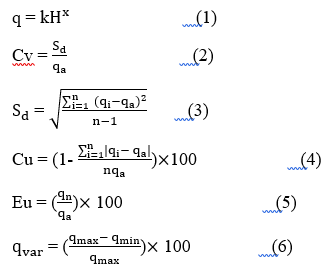

Also, to evaluate and monitor the system in field conditions, according to Merriam and Keller recommendations (1978) and the ASAE standard, in both fields on the main manifold, four lateral were selected (beginning, one-third, two-thirds, and the end) and in each lateral, four part (beginning, one-third, two-thirds, and the end) were selected. In each point, the soil is around of each emitter was excavated. Sadler et al. (1995) found that excavating the emitter in subsurface drip irrigation, would increase the flow rate between 8.2 to 4 percent, but this in rise would not having effect on the uniformity calculations. Then for three minutes, water discharged was collected. Also by barometer, the pressure was measured at these points. The emitters were installed at three spaces L1= 50, L2= 60, L3= 75 cm and three depths D1= 15, D2= 20 and D3= 30 cm. At spaces of L1 and L2, the emitters discharge was 1.2 (l/h) and at a L3, the discharge was 2.2 (l/h). Schematic of spacing, installation depth and type emitters and the position of the measuring points are shown in figure (4).

Based on the ASAE evaluation indexes including discharge coefficient of variation, statistical uniformity, hydraulic pressure coefficient of variation, and by taking hydraulic flow, overall emitter performance was calculated using Equations (8) to (12). In this way, the performance of the system was evaluated six times. The first time was at the beginning of sugarcane cultivation in 2016 and the second time was down after sugarcane harvest in 2017 and the beginning of the first ratoon. The third, fourth, and fifth turns were in the among of the growing season of the first ratoon and the sixth turn was done at the end of the last irrigation for the first ratoon in November 2018. The below equations used:

Where Vqs and Uqs are the discharge coefficient of variation and the statistical uniformity. If in these equations, hi is replaced by qi, the average head pressure h and hydraulic pressure coefficient of variation Vhs are obtained (Camp et al., 1997). Equation (9) is used to calculate the variation of the discharge by considering the hydraulic flow Vqh:

In this equation, x is flow exponent, which is calculated in the laboratory. The statistical uniformity is calculated by considering the hydraulic flow of equation (10):

The overall emitter performance depending on the variation of the
discharge due to various factors such as pressure and temperature changes inside the pipe network, the shape of the emitter, the clogging, also its exhaustion, is calculated from equation (11) (Camp et al.,1997):

The amount of the percentage of completely clogged emitters was measured using equation (13) (Zamaniyan et al., 2014):

In which: Pclog is the percentage of completely clogged emitters, Nclog is the number of emitters with complete clogged and N is the total number of emitters evaluated.
1. Laboratory results
The most important feature of the emitters is the relationship between the discharge variations and the pressure. The superiority of the pressure regulating emitters to the non-regulated is this point that with research the pressure level to the effective value, the pressure setting occurs and the amount of discharge remains effective at higher pressures. (Bush et al. 2016, Mohammed Elamin et al. 2017). In the studied emitters, the effective pressure was 0.5 bar. With pressures higher than 5 bar it should not have any effect on the flow rate. Multiple measurements in the laboratory reflect this fact that the pressure variations have had a small effect on the variation of the discharge. The results obtained from the study of emitters in the pumping laboratory are presented in Table 5.

According to the results in Table 5, the amount of (x) is very small and negative in relation to the discharge and the pressure for emitters and it is close to zero and it indicates this matter very well that the flow is not affected by pressure variation. This result is consistent with the self- controlled pressure of the emitters. This result is corresponding with the results of Mohamed (2013) and Bush et al. (2016), which both investigated the hydraulic performance of the pressure regulating emitters. Their results showed that in these emitters, by rising in pressure almost the discharge emitters remain constant. These results are also consistent with the Li et al. (2007), Farasati et al. (2011) and Maroufpoor and Parvini (2014) results. They also obtained the negative value of x in the discharge and pressure equation for the pressure regulators emitter.
The value of x for the discharge was 2.2 liters per hour -0.007. This is consistent with the results of Li et al. (2007). They obtained a value of x -0.04 by studying a pressure regulators emitter with a discharge of 2.3 liters per hour in the laboratory. Also, according to the ASAE standard (Keller and Karmeli, 1974), the coefficient of variation which is obtained in the laboratory, is in the range of medium to acceptable range. By comparing the results of Table 5 and Table 4 with the information in the catalog, it can be seen that although both x and k are close in two tables, but there is a much difference between the actual coefficient of variation, which is 15 percent, compared to its amount in that is reported to catalog maximum of 4 percent.
The reason for this can be attributed to the large number of emitters tested at the manufacturing plant. Because the limitation of the number of emitters on the farm increases the error of the test.
This suggests that the design of the irrigation system should not only be limited to the information of its catalog. This result is corresponding with the results of Li et al. (2007), Safi et al. (2007) and Hezarjaribi et al. (2013). Li et al. (2007) and Safi et al. (2007), by studying several types of pressure regulator emitters in the laboratory, concluded that the variation of discharge measured in the laboratory were 10% and 6.5% respectively higher than the values of reported by its manufacturer. Hezarjaribi et al. (2013) during their research, they studied the performance of three types of emitters, including controlled and non-controlled pressure, at four different pressures. Then they compared the information obtained with the information provided by the manufacturer. Their results indicated that in the controlled pressure, the variation in the discharge is more than the information of the catalog. The high Cv value can be attributed to the pressure-regulating emitters because this type of emitter is more difficult to manufacture than non-regulated pressure emitters. This result is in line with the results of Al Amoud et al. (2014). They by studying several types of regulated and non-regulated emitters in the laboratory, concluded that the Cv in the regulated emitters averaged 0.049 and above its value in the non-regulated emitters averaging 0.017.
measured in the laboratory for all three emitters it is over 20%. This result is corresponding with the results of Hezarjaribi et al. (2013) and Gharcheh et al. (2015). They also measure the qvar for controlled pressure emitters 20 and 24.6%, respectively. The average (Cu) and (Eu) are 90% and 88%, respectively, which is close to the results of Bush et al. (2016). They obtained 91% and 87% (Cu) and (Eu) values for a controlled pressure emitter under laboratory conditions and at a pressure of 1.75 bar, respectively.
2. Fields results
In figure 5, The number of percentage average of completely clogged emitters is shown for evaluations. As shown in figure 5, average of the percentage of completely clogged emitters has increased over time. The amount of Pclog increased 10% by the end of the evaluation period, which is in the excellent class according to ASAE classification. This is in line with the results of Zamaniyan et al. (2014). It is measured this value below 15% for the studied drip irrigation systems in Khuzestan province. Also, according to Capra & Scicolones (1998) classification, the system under study has shown excellent performance.
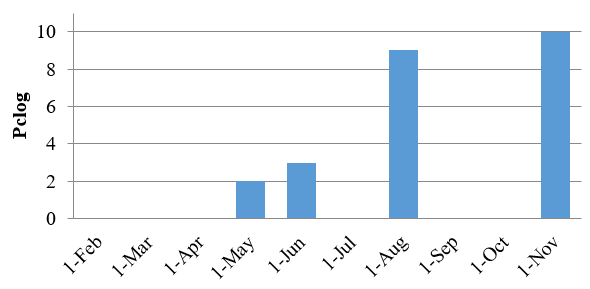
In Tables 6, the results of the measurement of the discharge and the pressure of the emitters are shown in six steps. The measured values are the average of two emitters in each point.
According to the results presented in Table 5, non-uniformity is observed in the discharge rate of the emitters. For example, in some of the emitters on a lateral, discharge suddenly dropped or during the evaluation steps, emitters discharge decreased significantly. The reason for this matter is the slight clogging in emitters by increasing the duration of the system's operation, especially during the fertilization period from May to June. This result is corresponding with the results of Bagheri et al. (2015). They tested by studying a subsurface drip irrigation system for citrus and peach gardens in the Kordkuy region in Iran. They concluded that, non- uniform distribution can be attributed to some factors such as physical, chemical, and biological clogging, such as the entry of soil particles or roots of the plant into the emitters, or sediment in them, frictional drop, the duration of the use of the emitters and type of irrigation system designment. Another remarkable point in Table 6 the reduction process was interrupted and increased in some emitters. The reason for this is the reduction because of the partial clogging of the emitters by acid washing. This result is considering with the results of Li et al. (2007), Li et al. (2015), Liu et al. (2017) and Pan et al. (2018). They investigated the effect of fertilization on clogging. They found that the fertilizer has a clear accelerator effect on emitter clogging and its effect is more pronounced in fertilizer with higher concentrations. It is advised to clean the pipes after irrigation as much as possible and well. In addition, according to Table 6, observed that the amount of discharge in the two-thirds and the end is lower than the beginning lateral. Given this decline, it can be said that lateral end emitters were not properly washed. Therefore, when washing laterals, the duration of the wash should be considered based on the end emitters to ensure proper washing. This result is in line with the results of Tang et al. (2018). By examining the effect of fertilizer concentration and design changes on the emitter clogging, it is concluded that the end emitters needed more time for washing and elimination of clogging after fertilization.
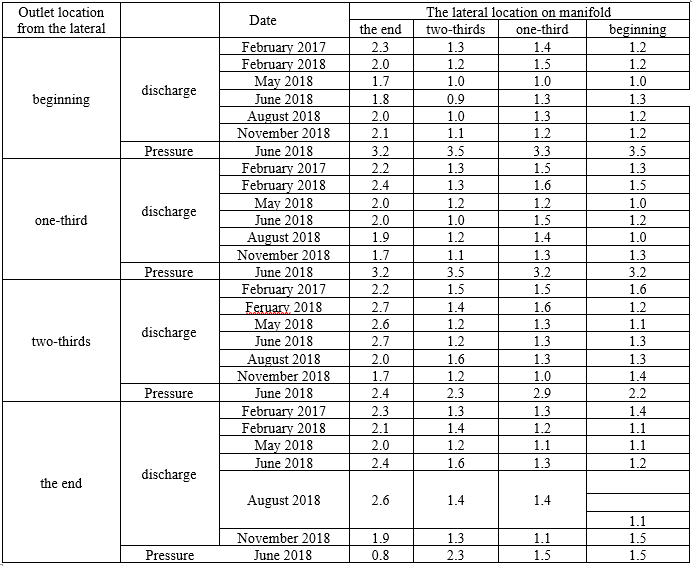
Hydraulic evaluation results
The results of the hydraulic evaluation are presented in Table 7.
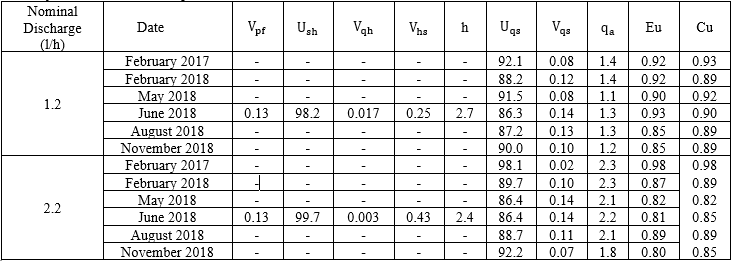
The statistical uniformity of discharge has been done excellent in both systems and at all steps according to the ASAE (Lamm et al. 1997), has been done excellent, while the rate discharge coefficient of variation is at the beginning of the launch of the systems in “excellent” to “acceptable” range. This index dropped to “acceptable” to “very bad”at the end of the first crop season. This result can be justified by discharge in emitters that explained in the previous section. This result is corresponding with the results of Pan et al. (2018). They investigated the effect of washing and fertilizer concentration on the performance of a drip irrigation system. Their results showed that increasing of fertilization would reduce the Eu. The average (Eu) for this farm is 87.8%. This result is close to the results of Camp et al. (1997), Safi et al. (2007) and Puig- Bargues et al. (2010). They reported 83.2%, 84.8% and 87.7% for the subsurface drip irrigation systems studied, respectively. This result is also in agreement with the results of Zamaniyan et al. (2014). It is reported (Eu) values above 60% for the studied drip irrigation systems in Khuzestan province. The minimum and maximum values (Uqs) for this farm is 86.3 to 92.2, respectively. The maximum amount occurred in November 2018 and the minimum amount occurred in june 2018. This result is in agreement with the results of Asgari et al. (2007) and Safi et al. (2007). Asgari et al. (2007) studied 14 different drip irrigation systems and obtained (Uqs) in Iran from 72 to 88. Safi et al. (2007) also obtained Uqs for a subsurface drip irrigation system in Tabriz region in Iran 93.8. For these farms value of (Uqs) were “good” at all stages. Only in the last step of the evaluation has this parameter been reduced to “acceptable” range. This is because the (Vqs) has reached its maximum value in the last evaluation stage. The maximum and minimum values (Vqs) for these fields were averaged between 0.08 and 0.21, respectively. The minimum amount occurred in February 2018 and the maximum amount occurred in November 2018. This result is in line with the results of Asgari et al. (2007). They reported (Vqs) between 0.08 to 0.28. (Vqs) is within “acceptable” of the first to fourth stages of evaluation. But this index reached its highest level in the last stage and it put systems performance in a “very bad”. The incensement of the variation of discharge can be attributed to the effect of increasing the duration of the emitter use and increasing physical, chemical and biological clogging on the operation of emitters. This is corresponding with the results of Bagheri et al. (2015). According to the results in Tables 8 and 9, it seems that the value of this index in May, June and August of 2018 has reached its maximum in both systems, and the performance of the systems is completely in a “very bad” range. The reason for this is the coincidence of the evaluation and fertilization of sugarcane. After fertilizing, carbonate clogging increases, which can be solved by acid injection. After acid injection at the end of the second growing season, the amount discharge coefficient of variation decreased and the performance improved to “acceptable” range. This result is corresponding with the results of Elobaid (2006) and Mohammed Elamin et al. (2017). They said that installing and setting up filtration equipment would solve some of the problems but cannot completely eliminate it. Therefore, different methods should be used to remove sediments with acid.
The average value (Vpf) for this system was 0.13. So these systems are relatively “fairy” in terms of (Vpf). This is a good performance, according to the results of Zamaniyan et al. (2014) who calculated (Vpf) values for systems studied in Khuzestan region above 0.30. This result is in agreement with the results of Camp et al. (1997) and Safi et al (2007). They also obtained (Vpf) values for their studied subsurface drip irrigation systems at 0.186 and 0.13, respectively. (Ush) for this system is 99 on average. According to the ASAE standard (Anonymous, 1994), the Ush index is “excellent” systems. Excellent Ush indicates that the pressure variations in the emitters discharge were very little effect. This can be justified by considering the controlled pressure of the emitters. According to the Equation (12), if the variations of the discharge emitters are at their lowest in relation to the pressure variations, the value Vpf will depend on the amount of Vqs. Therefore, an incensement in the amount Vpf can also be attributed to the partial clogging of the emitters. This result is considering with the results (Camp et al. 1997). In their research about subsurface drip irrigation system, due to the excellent Ush, placed the Vpf in a fairly for reasons other than inappropriate hydraulic design, such as clogging.
The maximum and minimum (Cu) and (Eu) values occurred in February 2017 and June 2018, respectively. This is due to increase in systems operation time and partial clogging of the emitters, especially in the fertile season, which increase the variation of discharge. This result is in agreement with the results of Ranjan et al. (2018) and Tanga et al. (2018). Ranjan et al. (2018) evaluating the performance of a drip irrigation system at with different pressure levels. They reported that the (Cu) decreased with increasing variation discharge. The results of Tanga et al. (2018) also show that increasing fertilizer concentration and design changes significantly reduce (Cu) and (Eu). The reported (Cu) value for different systems is between 17.4% and 95.2%. For drip irrigation, (Cu) is usually about 81.2% (Saxena et al. 2019). The mean (Cu) and (Eu) values for this system are 90.8 and 85.4%, respectively. Given these values, it can be said that the systems perform well and it “very good”. These results are in line with the results of Ashiri et al. (2014). They reported the mean (Cu) and (Eu) values for drip irrigation systems in Khuzestan region were 94.7 and 91.2, respectively.
In this research, the conditions of sugarcane subsurface drip irrigation fields were evaluated for the first time in Iran, both in the laboratory and in the field conditions during the two years (agronomical season). According to the ASAE recommendation, the studied systems are acceptable for the overall emitter performance of the emitters and emission uniformity. According to the hydraulic evaluation carried out, the studied systems has a good design. The value (Cu) of this system is optimal and expected. Evaluation of indexes showed that the system performance decreased due to the physical, chemical and biological clogging, especially at the time of fertilizing. Emitter clogging can pose a serious problem to system performance and should be considered. It is recommended that the pipes be thoroughly washed after fertigation. A good fertilizer and acid washing program can help improve system performance. Longer-term evaluation studies for these farms, as it is the first experience of installing a subsurface drip irrigation system for sugarcane farms in the region, seems necessary. Also, study of the emitter's performance in the laboratory show that the results are different with the catalog information. Therefore, future designs should be based on laboratory results. A well-designed and accurate program can help improving system performance for fertilizer and acid washing.